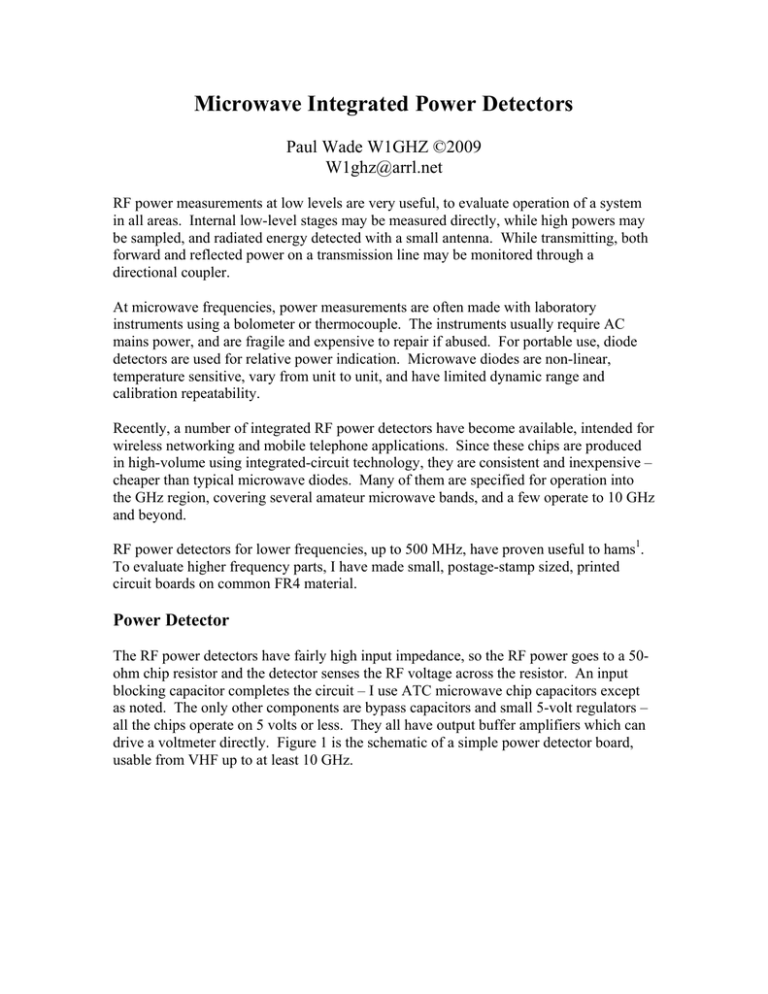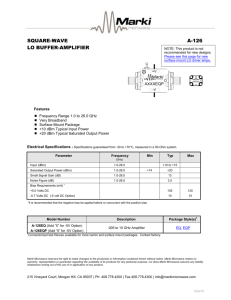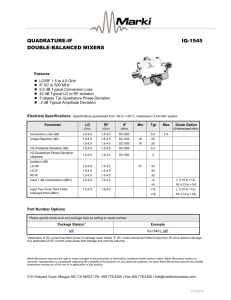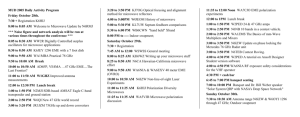Microwave Integrated Power Detectors
advertisement

Microwave Integrated Power Detectors Paul Wade W1GHZ ©2009 W1ghz@arrl.net RF power measurements at low levels are very useful, to evaluate operation of a system in all areas. Internal low-level stages may be measured directly, while high powers may be sampled, and radiated energy detected with a small antenna. While transmitting, both forward and reflected power on a transmission line may be monitored through a directional coupler. At microwave frequencies, power measurements are often made with laboratory instruments using a bolometer or thermocouple. The instruments usually require AC mains power, and are fragile and expensive to repair if abused. For portable use, diode detectors are used for relative power indication. Microwave diodes are non-linear, temperature sensitive, vary from unit to unit, and have limited dynamic range and calibration repeatability. Recently, a number of integrated RF power detectors have become available, intended for wireless networking and mobile telephone applications. Since these chips are produced in high-volume using integrated-circuit technology, they are consistent and inexpensive – cheaper than typical microwave diodes. Many of them are specified for operation into the GHz region, covering several amateur microwave bands, and a few operate to 10 GHz and beyond. RF power detectors for lower frequencies, up to 500 MHz, have proven useful to hams1. To evaluate higher frequency parts, I have made small, postage-stamp sized, printed circuit boards on common FR4 material. Power Detector The RF power detectors have fairly high input impedance, so the RF power goes to a 50ohm chip resistor and the detector senses the RF voltage across the resistor. An input blocking capacitor completes the circuit – I use ATC microwave chip capacitors except as noted. The only other components are bypass capacitors and small 5-volt regulators – all the chips operate on 5 volts or less. They all have output buffer amplifiers which can drive a voltmeter directly. Figure 1 is the schematic of a simple power detector board, usable from VHF up to at least 10 GHz. Figure 1 LTC5508 The LTC5508 from Linear Technologies (www.linear.com) is rated to 7GHz, but works well at 10 GHz. This chip, in a tiny 6-lead SC-70 package required a simple test board shown in Figure 2. The schematic is Figure 1 – a wire for the Enable pin is under the board. The upper frequency response exceeds 10 GHz, shown in Figure 3, although it is roughly 3 dB down at 10.368 GHz. The usable dynamic range is greater than 30 dB, from -20 dBm to +13 dBm. With a lower frequency range of about 100 MHz, this chip covers all the amateur VHF, UHF, popular microwave bands with a dynamic range comparable to the older commercial power meters such as the HP 432. Power requirements are a few milliamps at 3 to 5 volts. On the simple PC board shown in Figure 3, the LTC5508 works up to at least 12 GHz, although only for powers below about 0 dBm at frequencies above 8 GHz. At 24 GHz, it detects power, but I haven’t measured the response – just knowing that something is coming out of the antenna is enough. Figure 4 shows that the response is good down to about 100 MHz, so that it covers the amateur VHF, UHF, and common microwave bands. Figure 5 displays the expected square-law response curve. Figure 2 LTC5508 Frequency Response Output in millivolts 2000 1500 10 dBm 5 dBm 0 dBm -5 dBm 1000 500 0 0 2 4 6 8 Frequency in GHz Figure 3 10 12 Output in millivolts LTC5508 Frequency Response 1800 1600 1400 1200 1000 800 600 400 200 0 10 dBm 5 dBm 0 dBm -5 dBm 10 100 1000 10000 Frequency in GHz Figure 4 Output in millivolts LTC5508 Sensitivity 2200 2000 1800 1600 1400 1200 1000 800 600 400 200 0 100 MHz 500 MHz 1000 MHz 3 GHz 6 GHz 10 GHz -30 -20 -10 0 10 20 Power in dBm Figure 5 LT5534 The LT5534 is a logarithmic-amplifier type detector rated to 3 GHz with 60 dB of dynamic range. One advantage is that the package and pinout are the same as the LTC5508, so I could use the same PC board. Figure 6 shows that the output is linear in dB, about 40 mV/dB, from -60 dBm up to about -5 dBm. Figure 7 shows that the frequency response is good up to about 3.5 GHz. LT5534 Sensitivity Output Voltage (millivolts) 3000 2500 2000 1500 100 MHz 1000 500 MHz 500 1000 MHz 0 -70 -60 -50 -40 -30 -20 -10 0 10 Power in dBm Figure 6 LT5534 Frequency Response Output Voltage (millivolts) 2500 2000 1500 1000 ATC 8pf 500 1000pf 0 0 500 1000 1500 2000 2500 3000 3500 Frequency in MHz Figure 7 I chose the LT5534 detector to monitor the input power in my Handheld Network Analyzer2, so that I could maximize the measurement dynamic range with an input power of about -30 dBm. To improve the low frequency response, I made one with a 1000 pf input blocking capacitor (0402 size) rather than the 8.2pf ATC microwave chip capacitor. Figure 8 shows the improved low-frequency response without degrading the higher frequencies. Apparently, expensive microwave capacitors are not essential. LT5534 Frequency Response Output Voltage (millivolts) 2500 2000 1500 1000 ATC 8pf 500 1000pf 0 1 10 100 1000 10000 Frequency in MHz Figure 8 Applications The obvious use is measurement of power. In addition to monitoring transmit power, the output could be used for an ALC circuit to control drive power to an amplifier. With a dual-directional coupler, both forward and reflected power may be monitored. Two of the detectors with linear-in-dB output could provide Return Loss directly, from the difference between the outputs. A sensitive detector is valuable for antenna work, such as radiation pattern measurement. The sensitive detectors are also useful for low-level power measurements; the power range may be extended and VSWR improved by adding attenuators. My favorite use is an “RF Sniffer,” to detect radiated power during portable operation. I made a unit3 with an AD8307, for low frequencies, and an LTC5508, for UHF and microwaves, and a bargraph indicator to display relative power. When I set up in a new location, I hold the unit, shown in Figure 9 with a broadband log-periodic antenna by WA5VJB4, in front of the antenna to verify output. The circuit board is shown in Figure 10. Figure 9 Figure 10 The RF sniffer can also detect RF leakage; checking a microwave oven is a good test. Amateur power amplifiers should also be checked for leakage, since some of them run even higher power than a microwave oven. The integrated power detectors have a fast response, so that they may be used to detect modulation, even high-speed digital types. An oscilloscope on the output might be useful for tracking down digital interference. They may also be used to detect noise levels, for instance, sun noise from an antenna. However, the fast response is of little value here, and an integrator on the output is necessary to smooth the response and average the readings. Summary These inexpensive, readily available, microwave power detectors offer performance rivaling or exceeding expensive lab equipment. Accuracy is lower, but adequate for many purposes. They are useful not only as test equipment, but also as part of operating equipment. The differing characteristics of the various chips should fit a multitude of applications. The printed circuit layouts that I made for these detectors are available on my website, www.w1ghz.org. While they may be copied directly, please feel free to modify them and incorporate them in other projects. References 1. Wes Hayward, W7ZOI, and Bob Larkin, W7PUA, “Simple RF-Power Measurement,” QST, June 2001, pp. 38-43. 2. Paul Wade, W1GHZ, “Antenna Ratiometry Measurements,” Proceedings of Microwave Update 2005, ARRL, 2005, pp. 40-63. www.w1ghz.org/small_proj/hna.zip 3. Paul Wade, W1GHZ, “Portable RF Sniffer and Power Meter,” Proceedings of the 30th Eastern VHF/UHF Conference, ARRL, April 2004, pp. 60-69. http://www.w1ghz.org/new/portable_powermeter.pdf (also available as kit ABPM from Down East Microwave www.downeastmicrowave.com ) 4. Kent Britain, WA5VJB, “Designing PCB Log Periodic Antennas,” Proceedings of Microwave Update 2000, ARRL, 2000, pp. 203-2008. www.wa5vjb.com






